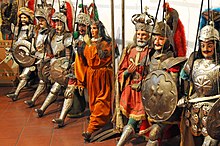Opera dei Pupi
Inscribed in the UNESCO's List of the Oral and Intangible Heritage of Humanity in 2001, it dates back to the third decade of the nineteenth century,[2] and was particularly successful among the middle and lower classes, becoming one of Sicily's most significant expressions of history and cultural identity.All these stories were elaborated in The History of the Paladins of France, written by Giusto Lo Dico, that is a "compilation of the Italian chivalric poems of the Renaissance in which the French literature of the Middle Ages was freely modified".The traditional repertoire of the shows also include historical-romantic narratives, stories of brigands, works by William Shakespeare such as Romeo and Juliette and Macbeth, and short farces.However, only in the first decades of the nineteenth century, in Sicily, did the chivalrous repertoire achieve such resounding success as to supplant all the others and determine a series of technical and figurative innovations.This was probably due to the delayed effect of the pre-romantic and romantic style of the Middle Ages; but it is also a consequence of ingenious technical inventions which made it possible to give extraordinary effectiveness to combat scenes which become a sort of exalting dance, with a crescendo rhythm and which arouses an intense psychomotory participation in the audience[7].There are numerous studies dedicated to Sicilian Opera dei pupi.Furthermore, we cannot fail to mention the fundamental studies of Giuseppe Pitrè and Sebastiano Lo Nigro as well as the book entitled Opera dei pupi by Antonio Pasqualino[8] (Sellerio 1977).Over time, the Opera dei pupi has gone through some periods of serious crisis: Giuseppe Pitrè recorded its decline at the end of the nineteenth century; a new crisis dates back to the 1930s and was due to the spread of cinema; the most recent one, and even more incisive, is that of the Fifties and Sixties when the popular neighborhoods of the cities began to empty and to reject traditional culture began to be rejected following the spread of new forms of economic well-being of the consumerist era.Equipped with a wooden frame, the puppets are provided with real armor, richly decorated and chiseled, and vary in movement according to the "school" they belong to: Palermo, Catania or Naples.Christian warriors have kind faces and symmetrical features, wear a kilt (called faroncina in Palermo and vesti in Catania) and present their family's respective emblems on their helmets, chestplates and shields allowing the audience to recognize the characters.Although the crisis of the middle 19th century caused a significant irregularity of the shows (no longer being represented daily), even today the transmission of this heritage takes place according to traditional methods.In Catania, the repertoire also included: Erminio della Stella d'Oro, Guido of Santa Croce, Uzeta the Catanese, Farismane and Siface, Tramoro of Medina and Guelfo of Negroponte.«In Syracuse, in the historic theaters of the Puzzo family, the puppets, in size, weight, maneuvering system and repertoire are all similar to those of Catania; however, they have legs with a joint at the knee».This includes both historical material and that which is used for the realization of the shows":[16] Palermo: Alcamo: The Opera dei Pupi is attested in Campania and Apulia, where puppets have the same mechanics and figurative characteristics.In Naples, the cartelli are painted in tempera with pastel colors on wrapping paper or on canvas and depict a single scene on which a sheet was affixed that summarized the story of the day.also constitute a precious heritage of tangible assets capable of restoring the history of the Sicilian traditional puppet theatre including the different phases it went through, the innovations, and the talented artisans who animated it.



CataniaMarionetteSicilianUNESCO Intangible Cultural HeritageSicilyUNESCOCarolingian cycleRenaissanceOrlando innamoratoOrlando FuriosoGerusalemme LiberataWilliam ShakespeareRomeo and JulietteMacbethfarcesNaplesromanticMiddle AgesGiuseppe PitrècinemaMasterpiece of the oral and intangible heritage of humanityConvention for the Safeguarding of the Intangible Cultural HeritageChristianSaracenRolandCommedia dell'artepaladinsCharlemagneRenaudFerragutAngelicaGanelonMessinaSyracuseAcirealeSortinoPalermoAgrigentoTrapaniAlcamoCampaniaApuliaGuerrin MeschinoGeraciPartinicoMonrealeCaltagironeLicataRandazzoSulmonaTotò a coloriThe GodfatherPaladinCarolingean cycleMatter of FranceFortunato Pasqualino